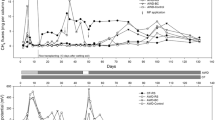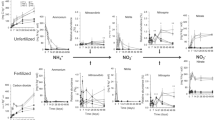Abstract
Laboratory experiments were conducted on the effects of rice straw application and N fertilization on methane (CH4) production from a flooded Louisiana, USA, rice soil incubated under anaerobic conditions. Rice straw application significantly increased CH4 production; CH4 production increased in proportion to the application rate. Urea fertilization also enhanced CH4 production. The maximum production rate was 17% higher, and occurred 1 week earlier, than that of soil samples which did not receive urea, possibly due to the increase in soil pH following urea hydrolysis. The increase in soil pH following urea hydrolysis may have stimulated CH4-generating bacteria by providing more optimal soil pH conditions or contributed to the drop in redox potential (Eh). The significant decrease in both the production rate and the total amount of CH4 by application of NH4NO3 was associated with increases in soil Eh after addition of this oxidant. Addition of 300 mg. kg−1 NO -3 -N increased soil Eh by 220 mV and almost completely inhibited CH4 production. However, this inhibitory effect was short-termed. Soon after the applied NO -3 -N was reduced through denitrification, CH4 production increased. When (NH4)2SO4 was applied, the inhibition of CH4 production was not associated with an increase in soil Eh which did not change significantly. A direct inhibitory effect of sulphate on methanogenesis might have been more important.
Similar content being viewed by others
References
Alexander M (1977) Introduction to soil microbiology, 2nd ed. New York: Wiley
Blake DR and Rowland FS (1988) Continuing worldwide increase in tropospheric methane, 1978–1987. Science (Washington, DC) 239: 1129–1131
Bouwman AF (1990) Soils and the greenhouse effect. John Wiley and Sons, New York
Bouwman AF and Sombroek WG (1990) Inputs to climatic change by soil and agriculture related activities. In: Scharpenseel (ed) Soils on a warmer earth, Proceedings of an international workshop on effects of expected climate change on soil processes in the tropics and subtropics, 12–14 February, Nairobi
Casada ME and Safley Jr. LM (1990) Global methane emission from livestock and poultry. Presented at the International Workshop on Methane Emission. April 9–13, Washington DC
Cicerone RJ and Shetter JD (1981) Source of atmospheric (CH4): Measurements in rice paddies and a discussion. J Geophys Res 86: 7203–7209
Cicerone RJ and Oremland RS (1988) Biogeochemical aspects of atmospheric methane. Global Biogeochemical Cycles 2: 299–327
Drever JI (1988) The geochemistry of natural waters. 2nd ed. Englewood Cliffs, New Jersey
Jackobsen P, Patrick Jr. WH and Williams BG (1981) Sulfide and methane formation in soils and sediments. Soil Science 132: 279–287
Khalil MAK and Rasmussen RA (1991) Methane emission from rice fields in China. Environ Sci Technol 25: 979–981
Lindau CW, Delaune RD, Patrick, Jr WH and Bollich PK (1990) Fertilizer effect on dinitrogen, nitrous oxide, and methane emission from lowland rice. Soil Sci Soc Am J 54: 1789–1794
Lindau CW, Bollich PK, Delaune RD, Patrick Jr. WH and Law VJ (1991) Effect of urea fertilizer and environmental factors on methane emissions from Louisiana, USA rice field. Plant and Soil 136: 195–203
Little AD (1989) Methane emissions from the air and gas production industries. Final report to Ruhrgas A.G., July 1989
Patrick Jr. WH and Dleaune RD (1977) Chemical changes in rice soils. In: IRRI symposium on soils and rice, pp 361–379 International Rice research Institute, Los Banos, Laguna, Philippines
Sass RL, Fisher FM and Harcombe PA (1991) Mitigation of methane emissions from rice fields: possible adverse effects of incorporated rice straw. Global Biogeochemical Cycles 5: 275–287
Schütz H, Holzapfel-Pschorn A, Conrad R, Rennenberg H and Seiler W (1989) 3-year continuous record on the influence of daytime, season, and fertilizer treatment on methane emission rates from an Italian rice paddy. J Geophys Res 94: 16405–16416
Seiler W, Holzapfel-Pschorn A, Conrad R and Scharffe D (1984) Methane emission from rice paddies. Journal of Atmospheric Chemistry 1: 241–268
Vermoesen A, Ramon H and Van Cleemput O (1991) Composition of the soil gas phase. Permanent gases and hydrocarbons. Pedologie 41: 119–132
Vlek PLG and Byrnes BH (1986) The efficiency and loss of fertilizer N in lowland rice. Fert Res 9: 131–147
Wang ZP, Delaune RD, Masscheleyn PH and Patrick Jr. WH (1993) Soil redox and pH effects on methane production in a flooded rice soil. Soil Sci Soc Am J (In press)
Winchester JW, Fan SM and Li SM (1987) Methane and nitrogen gases from rice fields of China — Possible effects of microbiology, benthic fauna, fertilizer, and agricultural practice. Water, Air, Soil Pollut 37: 149–155
Yagi K and Minami K (1990) Effect of organic matter application on methane emission from some Japanese paddy fields. Soil Sci Plant Nutr 36: 599–610
Author information
Authors and Affiliations
Rights and permissions
About this article
Cite this article
Wang, Z., Delaune, R.D., Lindau, C.W. et al. Methane production from anaerobic soil amended with rice straw and nitrogen fertilizers. Fertilizer Research 33, 115–121 (1992). https://doi.org/10.1007/BF01051166
Received:
Accepted:
Issue Date:
DOI: https://doi.org/10.1007/BF01051166




